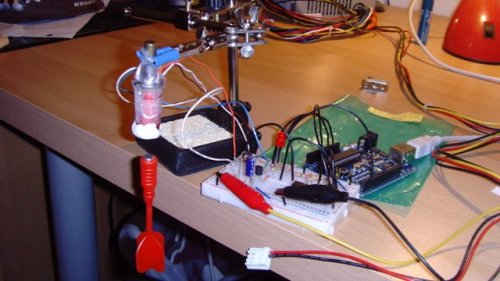I created a page that contains my notes on Wolfram’s Mathematica 6.
Posted in Mathematica | Tagged Mathematica bugs, Mathematica tricks | 2 Comments »
Recently, I implemented a Mathematica 6 version of the Weasel program by Richard Dawkins. It is a simple demonstration of the power of the process of cumulative natural selection as compared to random process. Continue Reading »
Posted in Mathematica | Tagged evolution, natural selection, Richard Dawkins, weasel program |
I stumbled upon an interesting statistical way of comparing various kanji learning systems when I played with XML kanji data available from Jim Breen‘s kick-ass KANJIDIC2 project (XML version of his KANJIDIC project). I present the findings below. Continue Reading »
Posted in Japanese, Mathematica | Tagged heisig, henshall, kanji, KANJIDIC2 | 3 Comments »
While working on my Arduino magnet levitation (details here), I stumped upon some problems with the way the compiler, AVR GCC, handles multiplication. I had to implement optimized multibyte multiplication routines because Arduino in my project preforms some digital signal processing with 20kHz sampling frequency. Since I couldn’t find those routines online, I’m posting the code of some of them here I posted the code on GitHub at https://github.com/rekka/avrmultiplication.
Posted in Arduino, AVR | Tagged 16bit, 32bit, Arduino, AVR, AVR GCC, multiplication | 4 Comments »
Recently, I finished my first Arduino project, a magnet levitation device. It levitates a magnetic object under an electromagnet. What makes it different from similar projects is the position sensor for the feedback loop. I use a single Hall effect sensor placed directly on the bottom of the core of the electromagnet. This creates a problem of separating the electromagnet’s field from the levitating magnet’s field. Fortunately, this can be done in software by the microcontroller ATmega168 that is the heart of Arduino Duemilanove, the board that I use to control the levitation. This article gives a detailed description of the project together with source code at https://github.com/rekka/levitation, as I promised.
WARNING: This is an advanced project that requires quite a substantial amount of tweaking and understanding of the software internals to make it work. Please consider this post just a description of what I did. Furthermore, it is more than 3 years old and therefore hopelessly outdated; the software most likely needs nontrivial changes.
Continue Reading »
Posted in Arduino | Tagged Arduino, electromagnet, Hall effect sensor, levitation, magnet | 22 Comments »
I found a couple of interesting magnetic levitation projects online when I was doing research for my Arduino magnet levitation project. I was also pointed out some really cool projects that I didn’t know about by visitors of my blog and of my Arduino forum thread. Here’s the list:
- http://de.sevenload.com/sendungen/Computerclub2/folgen/N7wXqna-Folge-20-Computer-club2 – video from a German podcast (in German), levitation starts at 16:25, they use ATmega8 and a Hall effect sensor in the base
- http://bea.st/sight/levitation/ – combined with a wireless energy transfer, uses ATtiny26, two Hall sensors on the coil, one on each side to compensate for the coil’s field. Also, check out his wirelessly powered levitating bulb.
- http://amasci.com/maglev/maglev.html – magnetic cradle, this is a levitation above electromagnets. Uses an array of coils with hall effect sensors to mimic a superconductor.
- http://sites.google.com/site/simerlab/ – professional magnetic levitation devices, above electromagnets.
Posted in Links | Tagged levitation, magnet |
It’s been only a couple weeks since I discovered Arduino, an open source microcontroller platform. I was looking for a cheap interface between my laptop and electronic circuits. Arduino with its price $35 and easy to use development environment was the best choice. So after getting my Arduino Duemilanove board and ordering some cheap components from AllElectronics, I had everything to start working on my old dream, making a magnet fly. Well, float.
Update: detailed description here
It took only a few days to figure out all the problems and my magnet floating device was born:

Floating a dart with Arduino
Here’s a video:
Posted in Arduino | Tagged Arduino, electromagnet, Hall effect sensor, levitation, magnet | 53 Comments »
I needed a fast communication between Arduino board and my laptop while working on my first Arduino project. I was monitoring an analog input, the reading on a Hall effect sensor, and some other variables that my Arduino program was using, and that all at a high frequency, 10 kHz. That was producing around 50 kB/s of data that I had to push through the serial connection. I accomplished this finally by modifying the wiring_serial.c file in the Arduino library. You can dowload the modified here.(See below) See the instructions on how to use the file below.
Posted in Arduino | Tagged Arduino, Serial | 10 Comments »